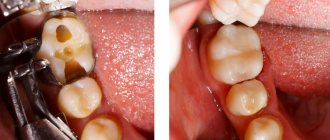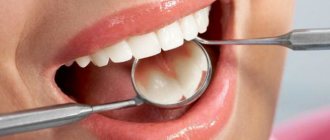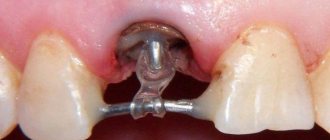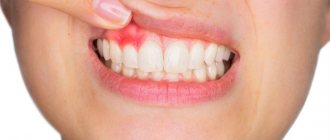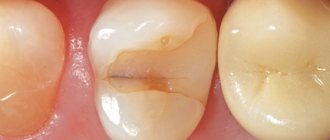Depulpation of a dental element is a procedure that allows you to kill a painful nerve that worries the patient. This manipulation requires the use of special painkillers, one of which is arsenic. To necrotize the dental nerve, arsenic paste is placed into the canal. To achieve the desired effect, the product must be kept for a certain time. Therefore, it is very important to know how much arsenic should be kept in the dental element.
Application in dentistry
Arsenic paste is used in the treatment of pulpitis for the purpose of analgesic effects on the pulp. However, in this case there are indications and contraindications.
Arsenic must be used:
- when a patient may have an allergic reaction to an anesthetic drug;
- if the anesthetic drug used does not have the maximum effect;
- there is not enough time for the anesthetic drug to take effect;
- if the patient has recently suffered a heart attack;
- the patient has hypertension;
- the patient is under the influence of alcohol.
Contraindications:
- when the patient has an allergic reaction to arsenic or anesthetic drugs that contain arsenic;
- if a child under three years old needs dental treatment;
- tooth roots are not sufficiently formed;
- if the patient is diagnosed with glaucoma;
- when the patient has pathologies of the genitourinary system;
- perforation of the roots of dental elements was diagnosed.
You can find out how treatment with arsenic works here:
Video - Specialist about arsenic in teeth
Indications and contraindications
The paste is used in cases where it is impossible to use modernly produced anesthetics. Such situations occur in certain indications:
- The patient is allergic to other anesthetics;
- If you need to urgently kill nerve fibers and remove a molar;
- When the patient cannot tolerate anesthesia for health reasons;
- Urgent treatment of patients with acute pain;
- Treatment of incisors, canines, molars in childhood when it is impossible to use local anesthesia;
Of course, like every drug, the paste has contraindications. The doctor must take them into account.
- It is impossible to put mass into a pathological tooth if the patient is under two years old.
- Keeping the paste is not allowed in case of chronic kidney disease or prostate disease.
- If the tooth canals are curvature, another remedy is used.
- The paste is not used at the moment of resorption of the roots of the chewing organs.
- This method is not used for glaucoma and allergies to components.
Stages of treatment
The initiation of therapy must necessarily begin with an examination using an x-ray. Then, if the pathology is confirmed, the specialist opens the carious cavity and removes dead tissue. Arsenic paste is placed into the cleaned channel. The final steps include filling the dental element with a temporary filling. The doctor determines the duration of arsenic exposure. The second visit is characterized by the removal of arsenic from the tooth and the dead nerve is removed. This manipulation is absolutely painless.
What symptoms should you contact your dentist for?
Ideally, you should visit the dental clinic with your child every six months, and if signs of caries appear, treatment should begin immediately. But more often, parents turn to specialists when their child begins to suffer from severe toothache.
You should make an appointment with a dentist if your child exhibits the following symptoms:
- feeling of bursting and dull toothache;
- reduction of pain after eating hot food or during sleep;
- tooth sensitivity when eating;
- purulent odor from the mouth even after brushing your teeth;
- extensive carious cavity;
- other damage to the dental crown.
Pulpitis is characterized by rapid progression of the inflammatory process. If the nerve is removed at the initial stage, there will be no complications. In advanced cases, the pathological process can develop into a cystic or granulomatous form, or the infection begins to spread to the jaw bones or sinus tissue.
How long should you keep arsenic paste in your tooth?
It is very important to determine how much arsenic should be kept. There are a lot of criteria here - the patient’s age, the drug used, pulp indicators (the drug is placed on a closed pulp or an open one). The average duration of exposure to arsenic on a nerve is 1 day. If multiple treatments are necessary, the doctor will increase the duration of action to two days.
If we are talking about the treatment of dental elements of children, then the extraction of arsenic should occur no later than 16 hours later.
Attention! There are modern medicines that contain arsenic. Their effect on the diseased nerve can be increased to five days.
Consequences of nerve removal
In the first 1–2 days after treatment, the tooth may hurt, but the intensity of the pain gradually decreases. To alleviate the condition, you can take analgesics recommended by a specialist. There are no other consequences of nerve removal.
Since pulpitis is most often caused by caries, during the treatment process the dentist removes the affected crown tissue. Restoring the integrity of the tooth is performed after removing the temporary filling. For correction, a filling material that does not contain toxic substances is used. In some cases, when the area of the carious cavity is too large and there is a risk of the filling falling out, it is recommended to install prostheses (stump or artificial crown.
Many parents mistakenly believe that depulpation implies the absence of a nerve in a permanent tooth. However, this is not at all true. Temporary and permanent teeth have separate systems and tissues that are not interconnected.
Martinka Children's and Adolescent Dentistry treats pulpitis by removing the nerve. Timely and correctly performed removal of the nerve of a baby tooth has no consequences. The integrity of the tooth is restored, and its functionality is preserved.
Recommendations
Since arsenic paste is poisonous, safety rules must be followed. It is important to come to your next appointment at the time agreed with your doctor. First of all, follow this list of rules:
- Maintain the integrity of the temporary filling. Initially, the filling is made airtight, so arsenic acts exclusively on the diseased nerve. If the integrity of the filling is damaged, arsenic comes out and affects the surrounding tissues. As a result, an inflammatory process occurs, which is accompanied by painful sensations.
- Do not exceed the period of exposure to arsenic.
- The specialist should not make a mistake with the dosage of the product.
What to do if you experience discomfort?
Often the patient may experience discomfort when exposed to arsenic, to minimize anxiety, it is recommended:
- rinse your mouth with soda solution if there is a sour taste. In this way, the acidic effect can be neutralized and burns can be avoided;
- after arsenic is introduced into the tooth, pain may occur; a glass of warm milk will be required to relieve it. To do this, hold the milk in your mouth for a few seconds, and then drink the drink completely.
Reference! Milk, namely the protein it contains, quickly removes arsenic from the body.
Does it hurt or not?
The sensitivity of teeth is provided by a nerve that is located in the pulp tissue. For this reason, both the pathology itself and the process of its elimination presuppose the presence of pain.
Dentistry has ample opportunities for painless treatment of pulpitis. Anesthesia is used for this. Modern drugs are safe and do not pose a risk to the child’s health.
Methods of dental anesthesia.
- Local anesthesia. An anesthetic is injected into the soft tissues, eliminating any sensation for a certain period of time. To ensure that the child does not feel the injection, topical anesthesia is additionally used.
- Sedation. The method is also called “medicated sleep.” Pain relief is achieved by placing the child under a mild general anesthesia. To administer the anesthetic, intravenous and inhalation methods are used. The duration of anesthesia is from 10 minutes to 2 hours.
When treating young children under 5 years of age, dentists give preference to medicated sleep. It is difficult for a child to simultaneously cope with fear and maintain a calm position, which can complicate the procedure and cause tissue injury. Sedation allows you to eliminate psychological trauma and any painful sensations, as well as make the dentist’s work easier and speed up the treatment process.
How harmful is arsenic?
Since this product is a type of poison, it is used for dental purposes in minimal dosages, with strict adherence to safety rules. Proper use of arsenic minimizes harmful effects.
If the timing of exposure to arsenic is violated, it can penetrate the tissue structure, accumulate there and cause complications. If some of the arsenic gets into the oral cavity, then a protracted inflammatory process should be expected.
With incorrect dosages of arsenic, the following consequences are observed:
- Dentin begins to turn black.
- Swelling and inflammation of the pulp occurs.
- Toxic effects on the body.
- Inflammatory process of periodontal tissue.
- Osteonecrosis.
Very often, the patient may ignore the deadlines indicated by the specialist. As a result, arsenic periodontitis occurs, the treatment of which requires a long time. When exposed to arsenic, tissue necrosis cannot be ruled out. If the patient experiences increased sensitivity, toxic damage to the intestines and liver subsequently occurs.
Video - Treatment of pulpitis
When is a child's dental nerve removed?
The main indication for removing a nerve in a child’s tooth is pulpitis.
The disease is characterized by inflammation of the pulp, in the tissues of which there are vessels and the nerve itself. Pulpitis is accompanied by severe pain, deterioration of general condition and weakened immunity. There are risks of inflammation spreading and complications developing. Nerve inflammation is a complication of deep caries. Microbes that penetrate the dentin gradually infect the pulp, resulting in pulpitis. If treatment is not carried out in a timely manner, the pathological process begins to progress, gradually spreading to the soft tissues, and then to the jaw bone.
Removal of the nerve of baby teeth is not carried out only if the child has already begun the process of changing teeth, and a permanent tooth is growing in the coming months. An x-ray is taken to determine the prognosis. For such indications, tooth extraction is performed, since there is no risk of bite displacement.
Arsenic extraction process
In the depulpation procedure, it is very important to remove arsenic in a timely manner. If you ignore this indicator, you can get the above complications.
Advice! When the patient is unable to visit the doctor at the appointed time, the arsenic must be extracted independently. To do this, wash your hands and disinfect them in advance. Then break the integrity of the seal and remove the arsenic. The danger of manipulation is that it can be swallowed. Therefore, procedures should be carried out with extreme caution. Upon completion of the manipulation, the oral cavity must be rinsed with a soda solution. In this case, visit the dentist as soon as possible.
How is arsenic used?
To kill a tooth, you will need to visit the dentist twice:
- The first time is to install the substance.
- The second is for removing it.
Installation
The procedure for your first visit is as follows:
- The doctor refers the patient to X-ray diagnostics of the diseased tooth. Having received the photo, he, focusing on it, will open the carious cavity. Then the inside of the tooth is cleaned of dead tissue.
- Then arsenic is placed on the site. A small cotton ball soaked in an anesthetic can be placed on top of it, which should relieve discomfort.
- The inside of the tooth is then sealed with a temporary filling to prevent dirt from getting in. The patient is released for 1.5-2 days. The doctor will tell you the exact number of days when scheduling the next visit.
Usually, the patient is advised to call if particularly severe pain occurs. If medications do not help and the condition worsens sharply, the doctor may advise you to go to the nearest dental department and remove the temporary filling, or do it yourself.
Arsenic installation process
Extraction
At the second appointment, the dentist removes the temporary filling. The cavity inside the tooth is carefully processed and then cleaned of arsenic residues. Then the doctor, having checked the sensitivity of the nerve, proceeds to remove it.
To make sure that the arsenic has been completely removed, a dye is added to the preparation before installing it, making the substance easy to see on the walls of the tooth.
Self extraction
If for any reason after applying the drug, prolonged pain appears, this means that the negative effect of arsenic has spread further to healthy tissues. In order not to delay removing the filling and paste, the patient can do it himself.
First, remove the filling itself: they are made of soft materials and are easily pryed off with a needle. The paste itself is also cleaned with a sharp, thin object (tweezers).
The main task is not to ingest arsenic during cleaning. Any instrument must first be disinfected, and then cover the open area with a cotton ball or swab.
Then the oral cavity should be rinsed with a solution of soda, iodine or hydrogen peroxide. Plus, you can rinse your mouth with milk - it also helps to neutralize any remaining substances. Afterwards, you should visit your doctor as soon as possible to avoid complications.
Use of arsenic for pregnant women
If a woman is a nursing mother or is pregnant, then the use of products containing arsenic is strictly prohibited. This is due to the toxic effect on the baby. When a woman is short of pregnancy, it is important to warn the dentist about the situation. Modern dentistry is rich in safer medications that are approved for use by pregnant women.
Brief information about this tool
Arsenic is the 33rd chemical element of group 15 from D. Mendeleev’s periodic table, a semimetal, quite brittle, steel-colored with small greenish inclusions. Arsenium is its exact chemical name. This is a toxic substance; the toxic dose for humans is only 5 mg.
It has been used in dentistry since the beginning of the 19th century. It helped to quickly cope with the pain, but killed all the soft tissue. At that time, doctors did not yet know how harmful the substance was to humans and did not calculate its dose.
Arsenic continues to be used to this day in dentistry, but no longer in its pure form. Arsenic anhydride (AS2O3) is used. It is a component of a nerve devitalization paste, in which its amount is minimal.
About the composition of arsenic paste
| Constituent component | Percentage % |
| Tannin | 1 |
| Antiseptic | 5 |
| Painkiller | 30 |
| Arsenous acid | 35 |
It is important! Additionally, auxiliary substances can be added to the paste, which are necessary for preparing a small dose.
The patient must remember that in no case should the duration of exposure to arsenic on the diseased nerve be exceeded, because this is fraught with dangerous consequences.
What is dental arsenic?
Since the substance itself is dangerous, experts have learned to produce a safer version by mixing arsenic with other active substances. This significantly protected the patient and at the same time increased the rate of death of nerve endings. The composition of such a product, available in the form of a paste, most often includes the following components:
- arsenic anhydride, which has the main necrotic effect, occupies approximately 30% of the total mass of the components;
- an anesthetic substance that allows you to relieve the pain syndrome of a decayed tooth, lidocaine, novocaine and dicaine are most often used, and also makes up almost a third of the total amount of active substances;
- an antiseptic that allows you to eliminate the active spread of bacteria, disinfect the pulp, while simultaneously reducing the inflammatory process and eliminating hyperemia of the mucous membrane;
- an astringent substance that allows you to enhance the effect of the paste and prevent it from leaking out of the diseased tooth, it is thanks to it that arsenic can be placed for 2-3 days;
- filler, which is small balls that allow you to measure a single dose of the active substance in order to avoid overdose and other dangerous processes.
Tooth with dental arsenic
Attention! Examples of such products are arsenic pastes called Kaustinerv, Pulpodent, Septodont .
Analogs
Today, the use of arsenic paste has become rare. Several modern products have been developed that are highly effective and completely safe.
Modern analogues are:
- Paraformaldehyde pastes - in addition to the main necrotizing effect, they have antibacterial properties, have a milder effect and do not lead to periodontal irritation. Their only disadvantage is the prolonged death of the nerve (it takes up to 6 days).
- Arsenic-free pastes – the most popular are the “Devit” group of products. The duration of nerve killing can be up to 10 days, but these remedies are completely safe for health.
Available in 3 forms:
- "Devit-A" - it contains a powerful antiseptic substance - paraform. Used for anesthetic and antiseptic compresses;
- "Devit-P" - used in the treatment of temporary teeth in cases where dead pulp will not be removed;
- “Devit-S” is intended for removing dead pulp after treatment in adults.
Which drug will be used to kill the nerve depends on many factors.
Why you can’t overexpose arsenic
The paste is placed into the tooth as a ball, in which the poison is only a third. Another 30% is an anesthetic drug (lidocaine, dicaine or novocaine) and an antiseptic. Therefore, the pain goes away within an hour, and adults often forget how long the medicine can be kept. And then they don’t come to the dentist to have it removed. This is a big mistake. Arsenic with prolonged exposure leads to:
- swelling of the pulp;
- darkening of dentin;
- necrosis of the periosteum;
- periodontal inflammation.
The most memorable sensation is acute pain when biting, which lasts up to 2-3 weeks and is very difficult to relieve with painkillers. Therefore, dentists always suggest, if it is not possible to visit the clinic on time, go to an ambulance or remove the medicine yourself.
Nuances of use during pregnancy and lactation
The use of arsenic paste during pregnancy and breastfeeding is prohibited! Even though the anhydride content in the product is minimal, its toxic effect on the intrauterine development of the fetus and the condition of the infant cannot be ruled out.
When visiting a dentist during this period, it is important for a woman to warn him about her motherhood.
There are many other arsenic-free drugs that have a similar effect, but are safe for the baby and the health of the mother.
